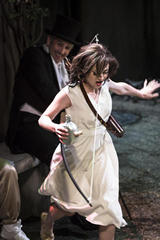| Opera Reviews | 26 April 2024 |
La Calisto in Strasbourg: A trip to the zooby Sandra Bowdler |
|
| Cavalli: La Calisto Opéra National du Rhin 30 April 2017 |
|
|
The scene is set in a rather dismal zoo, with a bear lurking at the bottom of an enclosure looked down up by visitors on an upper walkway. Centre stage is an apparently concrete cylinder flanked by iron rails containing the bear. This cylinder revolves to reveal various interiors. Several of the opera’s protagonists also feature as zoo employees in red uniforms, including Endimione as the bear’s keeper. Singing the prologue in the pit with the bear are Destino/Giunone who also appears to be a vet, Eternità/Diana and Natura/Pane (Pan). The opera proper begins with the descent from above of Giove in modern evening dress accompanied by Mercury in white pants and leather jacket, with tiny wings on his sneakers. Calisto and Diana appear in white peploi, while Giunone is resplendent in a glistening green Dior-style outfit with matching shoes, and her attendant peacocks are equally stylish with extendable tails. The satyrs leave nothing to the imagination. In this version, poor Linfea seems to get more than she bargained for, being carried off by satyrs and then uttering an offstage, outraged howl. Despite being few in number, Les Talens Lyriques provided sumptuous, disciplined sound, led as ever by Baroque master Christophe Rousset. Unusually, a harp was prominent in the basso continuo, played by Nicolas Achten. Giove in disguise as Diana was sung by the same singer as the real Diana, not the Giove singer, as has sometimes been the case in other productions. Vivica Genaux is perhaps the best known cast member, singing Diana in her rather oddly-toned voice, which is however powerful, flexible and accurate; her somewhat knockabout acting style served her well as a zoo cleaner, and as a very cross goddess when set upon by the deluded Calisto, but softening at the plaints of Endimione. Calisto was sung by Russian soprano Elena Tsallagova in quite a poignant performance. She also sang well in a strong, penetrating voice with a pretty top and warm overtones. The more seasoned performer Raffaella Milanesi has a less powerful voice, but showed great precision and control as the vindictive Guinone. As Endimione, Diana’s hopeless admirer, countertenor Filippo Mineccia was quite the romantic hero, languishing after the virgin goddess in full lament with honeyed tones. The aristocratic but louche Giove was portrayed by smooth bass Giovanni Battista Parodi, while the (appropriately) flightier Mercurio was well sung by Russian bass Nikolay Borchev. Lawrence Olsworth-Peter brought some bright tenor work to the role of Pan, and Guy de Mey has made something of a niche of the role of Linfea, the sturdy matron with the haute-contre voice, bringing to it a certain authority in what is essentially a comic role.
|
|
| Text ©
Sandra Bowdler Photo © Klara Beck |
|

 Seventeenth century opera, if it’s not by Monteverdi, isn’t the easiest sell in the opera house, but a couple of Cavalli’s works have a toehold in the repertoire, La Didone for instance, perhaps Giasone, and this one, La Calisto. Based on a classical legend, Calisto is one of those gormless nymphs, like Semele, on whom Giove casts an eye but who in this case is not interested, until he disguises himself as Diana and Calisto is seduced by Diana/Giove’s “chaste kisses” (however that works), thus annoying both the real Diana and of course the furious Giunone (Mrs Giove). The latter turns her into a bear, and Giove compensates (?) by placing her in the sky as the constellation Ursus Major. Cavalli has crafted quite a clever and attractive operatic work out of this, and Opéra National du Rhin has turned out an effective production, directed by Mariame Clément.
Seventeenth century opera, if it’s not by Monteverdi, isn’t the easiest sell in the opera house, but a couple of Cavalli’s works have a toehold in the repertoire, La Didone for instance, perhaps Giasone, and this one, La Calisto. Based on a classical legend, Calisto is one of those gormless nymphs, like Semele, on whom Giove casts an eye but who in this case is not interested, until he disguises himself as Diana and Calisto is seduced by Diana/Giove’s “chaste kisses” (however that works), thus annoying both the real Diana and of course the furious Giunone (Mrs Giove). The latter turns her into a bear, and Giove compensates (?) by placing her in the sky as the constellation Ursus Major. Cavalli has crafted quite a clever and attractive operatic work out of this, and Opéra National du Rhin has turned out an effective production, directed by Mariame Clément.





